CONTRACT RATIFICATION
Faculty vote to support new contract by over 98%
District faculty voted overwhelmingly to ratify the new contract agreement by a vote of 277 (98.57%) to 4 (1.43%) in the online vote that took place from Tuesday, September 24 through Friday, September 27.
The details of the new contract are shown below. The three-year contract provides a salary increase of 3.25% for this year (2013-14) and it guarantees a minimum increase of 2% for each of the next two years. Since our District is now a Basic Aid District, the agreement includes a clause that would trigger larger raises for 2014-15 and 2015-16 if property values increase more than 3% a year. (Property values in the county increased by 6% in the last year.) The contract also includes an additional 1% for Step 11 of the part-time salary schedule.
The medical cap the District pays towards faculty health benefits will increase starting in January 2014 when most of the plans increase their rates. The new monthly caps paid by the District will be $704 for Single, $1,026.34 for 2-party and $1,333.74 for family. Increases in the medical cap for the next two years will be renegotiated each year. The medical reimbursement for part-time faculty will be increased by $100 per semester.
Given that most community college districts around the state that have negotiated a new contract this year have typically been getting around 1% plus the state COLA of 1.57%, we are proud that our negotiating team was able to work collaboratively with the District to come up with a well-rounded and fair overall agreement.
New contract will increase pay 3.25% this year, then 2% each for ’14-’15 and ’15-’16, with greater increases if property values go up more than 3%
1. Three year agreement July 1, 2013 through June 30, 2016
2. Wage increases for all full and part-time faculty as follows:
3.25% effective August 19, 2013
2% effective with the beginning of the fall semester 2014
2% effective with the beginning of the fall semester 2015
Increase Step 11 of the Part Time salary schedules by 1.0% effective 8/19/13.
3. If the assessed valuation of property, as determined by the San Mateo County Assessor’s Office, increases by more than 3% for 2014-15 or by more than 3% for 2015-16, 60% of the assessed valuation increase above 3% will be added to the 2.0% compensation increases stated above effective with the beginning of the fall semester of that year. In no case shall the total increase for each year exceed 4.5% above the 2% noted in number 2 above. For example, if the assessed valuation increases 8.0%, then 60% of the 5%, i.e. 3.0%, will be added to the 2% of the given year.
The dates for measuring the assessed valuation to determine the calculation above are as follows:
For 2014-15 – July 11, 2014 and for 2015-16 – July 10, 2015
AFT determines how to allocate the additional compensation increase between full and part time faculty.
4. Increase medical cap as follows effective 1/1/2014:
Single: $50.00 per month
2 Party: $75.00 per month
Family: $100.00 per month
Medical Cap increases for 1/1/2015 and 1/1/2016 shall be negotiated as soon as medical rates for those years are provided to the District from PERS.
Increase part time faculty medical reimbursement $100 per semester for a total reimbursement of $600.00 per semester effective January 1, 2014
5. Previous tentative agreement on Article 7.11, Flex Day Obligations. (Provides more opportunities for part-time faculty to participate in flex day activities. See full language on AFT 1493 website.)
6. The District agrees to re-open negotiations on two non-economic items identified by AFT in 2014-15, and 2015-16.
PART TIME FACULTY
Disparity in student loans? How adjunct instructors are being excluded from the Public Service Loan Forgiveness Program
By Jeramy Wallace, CSM
Most community college instructors are undoubtedly saddled with a great amount of debt from their undergraduate, graduate, and professional studies. For many, student loan debt can reach into the tens of thousands and, for many of those, that debt is held by the Department of Education. But many community college instructors do not know that the Department of Education has a loan forgiveness program called the Public Service Loan Forgiveness Program (PSLF), which clears their outstanding balances after ten of years of public service and loan repayment.
PSLF requires either full-time employment or an accumulated 30 hours/week
As employees of a local government agency, community college instructors do qualify for this program. The PSLF requires that community college instructors are either full-time employees or work the full-time equivalent of 30 hours (which can be accumulated between institutions). Additionally, for teachers, the Dept. of Ed has stipulated that the eight-month academic year qualifies for the program (so those summer loan payments count). All instructors need to do is fill out the PSLF application and employment verification, enroll in a qualified loan repayment plan, and make the 120 on-time payments.
Sounds great, right? Not so fast. For full-time instructors, the PSLF program is pretty straightforward. Human Resources signs off that they are in fact full time and financial prosperity is just ten years away. But for part-timers, it is not so simple. The Department of Education stipulates that part-timers must work, between their various schools, the equivalent hours of a full-timer. This is where it gets tricky. Unlike full-time instructors, adjuncts are only paid for the time they spend in the classroom. So SMCCD adjuncts are only credited with working a maximum of 10 hours a week. If only that was the case! The district does not incorporate preparation, grading, or other professional activities in adjuncts’ hours. And because they don’t, part-time instructors are effectively excluded from the PSLF program.
Translating hours to percentages can give credit for actual hours worked
But there is a way for adjuncts to get credited for the time they actually work. Well, that is on the PSLF verification form, anyhow. It just requires a little arithmetic. Full-time employees spend a maximum of 15 hours in the classroom. Yet they are credited with 30 hours of work per week. The easiest way for adjuncts to calculate their own “true” hours is to calculate their percentage of full-time and to multiply that by 30 hours. So, for example, if an adjunct teaches 9 units, he or she would be 60% of full-time. Now, take that 60% and multiply it by 30 hours and the result is 18 hours of “true” work per week – not nine! Of course, it is easier to just double the teaching units, but this method does not logically illustrate the disparity between how full-time and part-time hours are calculated. And, yes, it is a pain that adjuncts must jump through so many hoops to participate in this program.
IRS finally realizes that adjunct hours should be calculated as a percentage of full-time
But hope is on the horizon. On January 2, 2013, the IRS questioned how colleges and universities calculate part-time hours. As noted in the Federal Register, a federal government journal, “some [IRS] commentators noted that educational organizations generally do not track the full hours of service of adjunct faculty, but instead compensate adjunct faculty on the basis of credit hours taught” (II.B.4). As mentioned above, “credit hours taught” does not recognize the time it takes to grade papers or exams, prepare for class, and, in some community colleges, meet with students outside of class. The article goes on to propose potential solutions to this disparity by “comparing the number of course credit hours taught by the adjunct faculty member to the number of credit hours taught by a typical non-adjunct faculty members working in the same or similar discipline who are considered full-time employees.” In other words, the IRS believes that educational institutions should calculate part-time hours as a percentage of full-time, just as above. Although this solution is not law, it is a sound basis for adjuncts trying to enroll in PSLF.
If you are an adjunct instructor interested in the Public Service Loan Forgiveness Program, visit the Department of Education’s website for details and repayment plan options. But when you go to have your employment verified, be prepared for resistance from Human Resources. They are not acting maliciously nor are they deliberately discriminating against you. They are simply using the information in front of them – your faculty load. But if you present the numbers as demonstrated above, you should be able to receive credit for your “true” hours worked. If not, contact your union representative. Unfortunately, this process will not get easier until the district updates its reporting formulas, which may not happen until the IRS acts on their recommendations.
ACADEMIC SENATE
As Community Colleges’ Mission Is Challenged, Senates’ Need to Highlight Colleges’ Positive Roles
By Leigh Anne Shaw, President, Skyline College Academic Senate
I should really know better than to check Facebook before bedtime. I logged on the other night to see that a researcher friend of mine at the UC had posted something that arrogantly disparaged community colleges. Oh, how conveniently we forget. Forget that the UC owes us a debt of gratitude for providing them with a steady stream of successful transfers to make up for the freshmen who drop out in the first year. Forget that U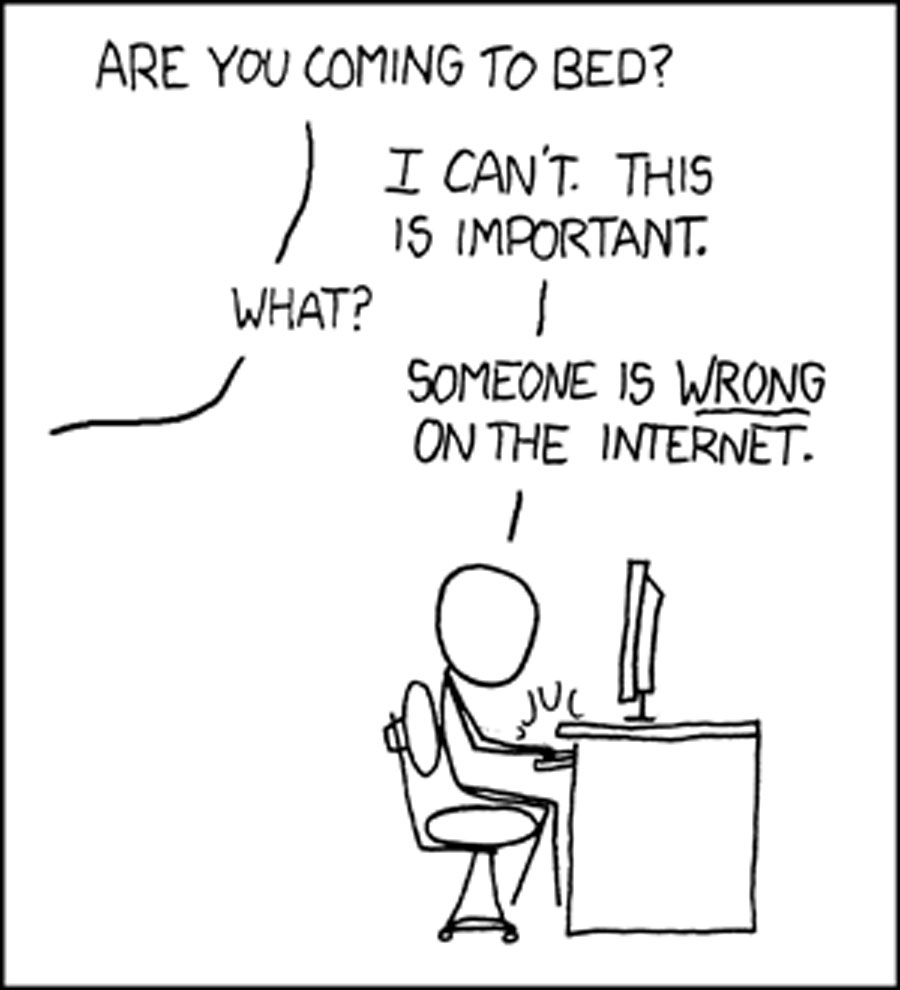 C itself states in its literature that CCC transfers are every bit as successful as native UC students. Did you ever see that “Someone is wrong on the internet” meme on xkcd.com? Yeah, that was me at 11:00pm, crafting a rather scathing deconstruction of my friend’s false notion right on her timeline. And you know what? I’d do it again because I’ve simply had it with those outside my area of expertise telling me my business.
C itself states in its literature that CCC transfers are every bit as successful as native UC students. Did you ever see that “Someone is wrong on the internet” meme on xkcd.com? Yeah, that was me at 11:00pm, crafting a rather scathing deconstruction of my friend’s false notion right on her timeline. And you know what? I’d do it again because I’ve simply had it with those outside my area of expertise telling me my business.
A year ago, the chair of the ultra-conservative group, California Competes, lambasted Senates for our hard-won roles in participatory governance. SB 1143 put Senates on the defensive with challenges to elements of the 10+1 such as professional development and policies regarding student preparation and success. Our mission is being called into question as the state aims to limit it to only transfer and certificate/degree awards. And even though we may be rejoicing in the US Dept of Ed’s scrutiny of the ACCJC, what it amounts to for the public is yet another negative image of CCCs. Each day we encounter a maelstrom of criticism by people who question our expertise and disparage our best efforts.
As Senates, I believe we need to work together to counter the fear and negativity that we’ve seen of late and change that conversation to a focus on what we do extraordinarily well: prepare students for transfer, careers, and a better life. To do that, I believe we need to exert more leadership and action in the following areas:
Policies regarding student preparation and success:
Who better than faculty to determine this? The curriculum debacle over repeatability and making serial courses available to students to ensure mastery is a prime example of how faculty need to be at the forefront of changes in legislation so that we can advise as to the likely scenarios that will result and avoid the issues we’re seeing now.
Degree and certificate requirements:
We need to engage collaboratively with the CSUs and UCs on transfer degrees while still advocating for the maintenance and integrity of local degrees (ASCCC Resolution 09.02 Fall 2012).
Educational program development:
As we attempt to better align our offerings with the needs of a community that supports us directly with property taxes, we must ensure that faculty are on the ground floor of any plans to create new programs.
Policies for faculty professional development activities:
Faculty need to be actively engaged in determining what training we need, and how we should get it.
As the old adage goes, “if you’re not at the table, you’re the main course.” Senates need to be proactive in asserting the 10+1 and preserving education for our students. This implies action at the state level, continuing down to the area, district and college levels, and even right on down to the conversations you have with people every day. Together, Senates need to ramp up a commitment to changing the conversation through direct action and showing California why community colleges are the best educational opportunity in the state.
Long-time AFT 1493 activist Chip Chandler steps down from union positions to pursue research work
At the end of the Spring, 2013 semester Chip Chandler (photo below) stepped down from his positions as the Skyline Chapter Co-Chair and the AFT 1493 Grievance Officer. At that time, Chip informed the AFT Executive Committee that he wanted to pursue other activities, including a new research project.
 While continuing his work as a kinesiology professor, Chip’s current research concerns brain plasticity using Wii balance games, mirror exercises, a rebounder and Interactive Metronome. In fact, Chip has had one or more research projects on-going for the past four years–now starting his fifth year. All projects are funded from the Skyline College President’s Innovation Grants and are collaborative research with Biologist, Shari Bookstaff, who provided Chip with the inspiration to do brain research due to her brain/body response to a brain tumor surgery. All of Chip’s subjects are students enrolled in Adaptive Kinesiology.
While continuing his work as a kinesiology professor, Chip’s current research concerns brain plasticity using Wii balance games, mirror exercises, a rebounder and Interactive Metronome. In fact, Chip has had one or more research projects on-going for the past four years–now starting his fifth year. All projects are funded from the Skyline College President’s Innovation Grants and are collaborative research with Biologist, Shari Bookstaff, who provided Chip with the inspiration to do brain research due to her brain/body response to a brain tumor surgery. All of Chip’s subjects are students enrolled in Adaptive Kinesiology.
Chip began his work as an AFT activist at Skyline in 1989. Without any formal grievance training at that time, Chip gathered information on complaints that came to his attention, and phoned this information to John Kirk, the AFT Chief Grievance Officer.
Chip was already a San Mateo County Mediation Officer and as such was called upon regularly to mediate disputes between students and instructors and disputes between instructors and Deans. These meetings were held in the Vice President of Instruction office. Over the years he worked with Susie Stevens, Del Anderson, and then Regina Standback-Stroud when they occupied this position at Skyline.
Chip received formal grievance training at a CFT summer school held at U.C. Santa Cruz in the summer of 1992. He next received arbitration training at the summer school in 1994.
Chip then handled his first grievance at Skyline, which concerned the denial of an adjunct faculty member’s seniority rights. Skyline President Linda Salter granted the grievance at Level I. From this experience Chip says: “I learned if I was well informed and reasonable, most administrators and faculty were amenable to negotiate and discuss possible solutions without the absolute necessity of filing a grievance as a first step to resolution.”
Over the years, Chip defended the AFT contract by gathering information from the Cañada and Skyline campuses when problems arose. He assisted the AFT Grievance Officer with three arbitrations by helping prepare witnesses and subpoenaing witnesses for the arbitration hearing.
Chip realized that the Academic Senate (AS) and AFT needed to work together on behalf of faculty. So he joined the Academic Senate at Skyline in 1990 as the Kinesiology, Dance and Athletics representative. He then began acting informally as a liaison between AFT and the Skyline AS. He later served as Vice President of the Skyline Academic Senate in 1995 and President of the Skyline AS in 1996.
From 1990 through May 2013 Chip served in some capacity in both AFT 1493 and the Skyline Senate. This included serving as the Skyline AFT Chapter Chair or Co-Chair.
Chip also served with John Kirk and Paul Stegner as the AFT Representatives on the first Performance Evaluation Task Force, which was then called the Trust Committee.
When asked what the motivation was for his union activism over the years, Chip mentioned his own personal experience while working in the District.
“I was illegally held out of my tenured job (tenured seven years at the time) for three years after a serious rugby injury in 1983 that paralyzed my right arm and hand that necessitated six major surgeries.”
AFT 1493 represented Chip in three separate grievances all related to his right to return to work. Chip says about his situation: “The absurd circumstances of denial of my tenured employment and conditions of return have been unparalleled in the SMCCD.”
Chip concluded his reminiscence: “That three ring circus prepared me for grievance work unlike any formal training could have. I realized then that administrators are in general poorly trained in human relations, nor do they usually have any understanding of the AFT contract. The fact is administrator training is inadequate and how to deal with real issues and the exact contract language seems to be lacking.”
The faculty in the San Mateo Community College District certainly owe Chip Chandler a debt of gratitude for all of the years he has spent representing their best interests. We wish Chip good luck in all of his future endeavors.
AFT 1493 endorses Richard Holober and Tom Mohr for November 5 Board of Trustees election
Four candidates are running for two seats on the San Mateo County Community College Board of Trustees in the November 5 election. AFT Local 1493 has endorsed two candidates — incumbent Trustee Richard Holober and Tom Mohr, past President of Cañada College. Holober and Mohr have each written articles (below) presenting their perspectives on their reasons for running and their goals for the Board.
Richard Holober
It has been a privilege to serve as a Trustee of the San Mateo County Community College District. I share AFT Local 1493’s commitment to excellent and affordable public higher education. I greatly appreciate the sacrifices your members made to keep the 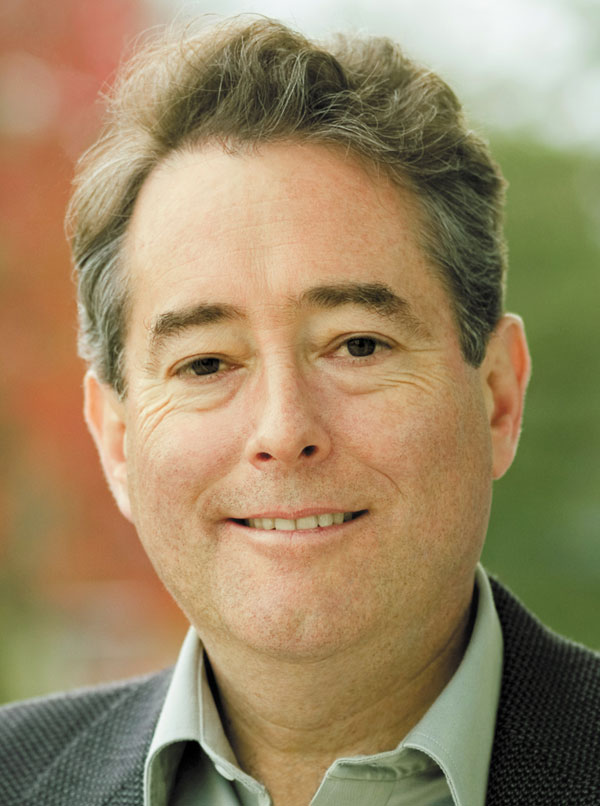 doors to college education open since the economy collapsed in 2008. We are now emerging from a long period of deprivation. I want to work closely with our faculty as we rebuild the promise of a higher education for all who seek it.
doors to college education open since the economy collapsed in 2008. We are now emerging from a long period of deprivation. I want to work closely with our faculty as we rebuild the promise of a higher education for all who seek it.
Five years of relentless budget cuts from Sacramento harmed public education from kindergarten through our college and university systems. Facing an unprecedented assault, I led our Board in placing the Measure G parcel tax before voters. Its passage has helped limit the damage to our District from the prolonged recession.
I joined my colleagues on the Board in directing our administration to avoid layoffs and pay or benefit cuts to our frontline educators. I’m proud of our track record during these tough times, especially when you compare our District to the statewide picture of dreadful staffing and compensation cuts in many other K-14 districts.
I thank our faculty for shouldering increased workloads and foregoing compensation increases. You are a key reason our College District’s core educational programs stayed intact during the lean years.
I am troubled by the growing wage and wealth gap between the top one percent of Americans and the rest of us. Sacrifice in tough times should include those at the top. Votes that I cast as a Trustee reflect my belief that while union-represented faculty and classified employees were enduring a multi-year pay and benefit freeze, it was only fair to expect the same of other, more highly compensated District employees.
As a Trustee, I strive to be open-minded, objective and independent in evaluating proposals around curriculum and pedagogy. Our goal should always be to enhance student success. Certain innovations in instructional technology are beneficial to our faculty and students. But labor cost-cutting is not a justification for substituting large distance education courses for the essential in-person classroom learning experience. When considering education technology proposals from business vendors, we should never lose sight that our student population includes many who enter our campuses lacking the preparation for college-level coursework. Your perspectives as educators matter greatly, and I ask you to participate in reviewing and commenting on these proposals.
Many of you are familiar with my career fighting for economic justice. I spent over two decades in the labor movement. For the past decade I’ve run a non-profit consumer rights organization. We work for better laws and regulations to protect working and retired Californians from corporate rip-offs when we spend our hard-earned pay. Throughout my working life, I have campaigned shoulder to shoulder with college faculty, classroom teachers, counselors, librarians, and your union for tax fairness and proper funding for public education and other vital social services.
Cañada College enabled my late wife Nadia to afford a college education. From Cañada, she went on to graduate from UC Berkeley and UC Hastings College of the Law, eventually becoming Mayor of Millbrae.
Her story is repeated thousands of times over each year in San Mateo County. We must have strong community colleges to preserve the American Dream for millions of Californians. I am committed to working closely with our outstanding faculty and certificated employees, and other District stakeholders to strengthen our College District for our students. As your Trustee, I will continue to honor our faculty’s extraordinary work serving our students.
Tom Mohr
It would be an honor to serve as a Trustee on the San Mateo County Community College District Board. When I started working at a Cañada College, I quickly found that what happens at a community college is transformative, that lives are  changed, that great teaching and opportunity to learn inspires individuals to become all they can be. This was an especially fulfilling experience for me because it connected with all the values, ideals and aspirations I had at the beginning of my career that caused me to become a teacher. It was for me, a sort of realized “Ithaca”, a journey I wish to continue.
changed, that great teaching and opportunity to learn inspires individuals to become all they can be. This was an especially fulfilling experience for me because it connected with all the values, ideals and aspirations I had at the beginning of my career that caused me to become a teacher. It was for me, a sort of realized “Ithaca”, a journey I wish to continue.
One cannot overstate the importance of the three community colleges to the destiny of the county and to its people. They are the places where the majority of citizens engage in higher education and prepare themselves to transfer, or receive career and technical training and then become gainfully employed. They are today, for most families of the county, the major avenue to affordable education. For so many of the people the colleges serve, they are the lone, available opportunity they have to advance the quality of their lives, to set goals and eventually join the ranks of those who compete successfully in a very challenging and dynamic economy. Without affordable education and training, provided in high-quality, state-of-the-art institutions of learning, the economy of the county, the very commonweal of its society, is seriously eroded and the presence of the democratic ideals of justice and opportunity to pursue a better life fall away.
A major challenge to all community colleges involves a clear imperative to increase the completion and graduation rate for those who enroll, most of whom indicate that their primary goal is to transfer to a university and complete the baccalaureate. Regardless of their manifest goal, however, the loss rate after one or two semesters is dismaying. We must put forward every effort to ameliorate this vexing and complex problem. There are models of innovation in various places where this situation is seen to be improving. I believe that the policy makers, those who have the ability to shape the direction of the district, can assist greatly through conscious and deliberate oversight, review of progress and most importantly, through investing in faculty, staff and programs that rigorously and professionally address the problem.
I am a strong advocate of District Strategic Planning. A good Strategic Plan is based on collected evidence, references the values and mission of the institution and sets forth the goals and accompanying plans for the district to pursue. It is neither lengthy nor arcane. It is most importantly the basis for communication and exchange of ideas between policy makers and practitioners. It becomes the basis for decisions that call upon the resources of the district. Major decisions of the Board reference quite naturally the Strategic Plan and its progress.
I believe that the progress of the District as an institution of teaching and learning, within which the most basis mission of all is the delivery of curriculum, is connected with the imperative to invest in great and effective teaching. The hallmark of a profession is the continual development of knowledge and skill that advances successful outcomes. Much of the communication between district and faculty should involve how the professionals of the organization are given genuine, meaningful opportunities to continually get better at what they do.
There are other matters a candidate for the Board thinks about, e.g. strengthening ties with business and labor market leaders in order to have the most advanced Career and Technical training or the various ways we might increase the number of students in the pipeline for science and engineering, but regardless of the goal, the desired outcomes of any educational plan require highly trained professionals delivering a carefully pondered curriculum.
It goes without saying, I hope, that the well being of the District and its academy, is rooted in the good health of the liberal arts. The educated person, facing huge societal issues, can apply the big ideas of history, philosophy, economics, the natural sciences and literature, and through these vehicles acquires inter-cultural understanding and vision. Let’s not forget, either, in our attention to the more immediate and practical, the impact of our sustaining the presence of the performing and visual arts.
Board Candidates Town Hall to be held at CSM on October 15
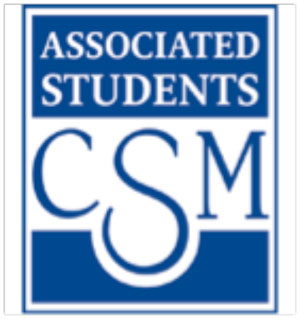 CSM’s Associated Students Advocacy Board will present a Town Hall for the four San Mateo County Coard of Trustees candidates on Tuesday, October 15 from 12:30 to 2:00 p.m. at CSM’s Bay View Dining Room in Building 10. The four candidates who will speak at the Town Hall are Samuel J. Diaz, Richard Holober, Tom Mohr and George Yang.
CSM’s Associated Students Advocacy Board will present a Town Hall for the four San Mateo County Coard of Trustees candidates on Tuesday, October 15 from 12:30 to 2:00 p.m. at CSM’s Bay View Dining Room in Building 10. The four candidates who will speak at the Town Hall are Samuel J. Diaz, Richard Holober, Tom Mohr and George Yang.
Come learn more about the candidates, ask questions and become a more informed voter.
For more info Contact The Center for Student Life and Leadership Development at: csmstudentlife@smccd.edu
KCSM
District makes deal with hedge fund group to sell KCSM-TV’s public airwaves to wireless companies
Blackstone Group to pay District $900K per year for 3-4 years and will then receive 38% of proceeds from sale of station’s “spectrum holdings”
by Tracy Rosenberg, Executive Director, Media Alliance
Time is running out for KCSM-TV. The 5th largest public television station in California, whose license has been owned by the College of San Mateo since 1964, has been placed in the safe-keeping of Locuspoint Networks, a commercial entity founded by former wireless executives. Locuspoint’s activities in “spectrum speculation” are described by Ben Mook in an article in the February 26, 2 013 issue of Current. Locuspoint, which is a 99%-owned subsidiary of one the nation’s largest hedge firms, the Blackstone Group, is described as one of three for-profit firms gambling on the upcoming TV auction to hit the jackpot buying and disposing of television stations around the country, including noncommercial ones like that belonging to the College of San Mateo.
013 issue of Current. Locuspoint, which is a 99%-owned subsidiary of one the nation’s largest hedge firms, the Blackstone Group, is described as one of three for-profit firms gambling on the upcoming TV auction to hit the jackpot buying and disposing of television stations around the country, including noncommercial ones like that belonging to the College of San Mateo.
So what does that mean for us here in the Bay Area? Local media watchdog group Media Alliance has observed the transactions surrounding KCSM-TV’s demise for more than two years and has filed several public records act requests to get more details on the actions of the SMCCD board. The requests have not always been responded to promptly (one filed in April of 2012 took more than six months to get any response at all), but the most recent one has provided supporting documentation for the Locuspoint deal. If you’d like to look at the documents, they have been posted on the Media Alliance website and can be downloaded.
Disturbing implications
Given the massive amount of lawyers involved, one can assume the legal dots have been connected at a significant cost, but the gist of the agreement has some disturbing implications. Here’s a quick version of what we’re looking at:
Locuspoint will subsidize the operations of KCSM-TV at the cost of $900,000 per year for the next 3-4 years. The District will operate the station at substantially reduced costs for this period, which indicates a program schedule consisting of a feed from one national program supplier, aired without closed captioning for the hearing-impaired or elderly, to cut station costs. Should the TV auction go forward during this period, on the receipt of a bid at or above the unknown number described as the “minimum acceptable bid” (which is blacked out), the station’s spectrum holdings will be surrendered to for-profit wireless companies and broadcasting will cease. The Blackstone Group via their “tactical opportunities division” will receive 38% of the proceeds in a massive shift of millions of dollars in public assets to the private capital firm.
Should the national spectrum auction not proceed within the designated time, then the speculator may exercise an option to sell off KCSM-TV’s license to any FCC-qualified bidder of their choice, with no right of refusal from the District. In practical terms, an FCC-qualified bidder can be any California not-for-profit corporation, including national chain Christian broadcasters like Daystar (a bidder in the earlier RFP). The District, in order to meet financial obligations to a hedge firm, has signed away the ability to exercise any discretion over the invasion into Bay Area broadcasting of entities who may not be desired or appreciated by the viewing community. The members of KCSM-TV, past and present, the college community, and the viewers will have no say. It’s up to the Blackstone Group.
Loss of airwaves = loss of public expression
This loss of control over college property poses some questions about the District’s interpretation of the preamble to their mission statement: “The District actively participates in the economic, social, and cultural development of San Mateo County. In a richly diverse environment and with increasing awareness of its role in the global community, the District is dedicated to maintaining a climate of academic freedom in which a wide variety of viewpoints is cultivated and shared”.
The financial pressures on higher education, and the California community college system in particular, are intense and should not be minimized. But by turning down an offer for $6 million dollars received last year, in search of greater short-term riches, the District’s Board of Trustee’s have brought to the campus community the kind of irresponsible speculation that has defunded public education and a host of services and damaged our economy – all to hand over a piece of the campus for profiteering.
It’s a real question whether the campus community, the viewing community and the residents of the Bay Area would have agreed to this if the District had ever asked them.
Campaign for a Healthy California organizing for Medicare for All
The Campaign for a Healthy California (CHC) is a new coalition of unions, senior organizations, worker justice centers, and community organizations committed to winning improved Medicare for All (a single payer system) in California. The CHC, which has been meeting since April, 2013, is committed to building and broadening a grassroots movement to replace private health insurance with guaranteed healthcare for all Californians.

The CHC supports many of the provisions of the Affordable Care Act (ACA), but that Act does not establish healthcare as a human right. The insurance industry continues to control our healthcare system, and patient care continues to be delivered based on ability to pay instead of health need.
Economists project four to six million uninsured Californians by 2019, and healthcare negotiations continue to consume money that would otherwise be available for cost-of-living adjustments. This situation drives down the standard of living for everyone.
The California Labor Federation is playing a prominent role in helping to launch this new effort for true health care reform. At this time the U.S. remains the only major industrialized country in the world that fails to provide healthcare as a fundamental human right for all of its citizens.
The San Mateo Labor Council has already endorsed this Campaign, as have many other unions in the Bay Area and throughout the State.
The AFT 1493 Executive Committee will be discussing its endorsement of this Campaign at its October meeting. In fact, AFT Local 1493 sponsored a single payer resolution at a CFT Convention several years ago, which unfortunately did not pass at that time. Later a single payer bill actually made its way successfully through the California legislature, only to be vetoed by then Governor Arnold Schwarzenegger.
So this is an idea that is long overdue, and whose time has perhaps finally come in California. For those interested in more information on this new Campaign, take a look at the CHC website: healthycaliforniacampaign.org.
![]()

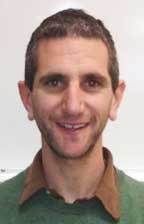
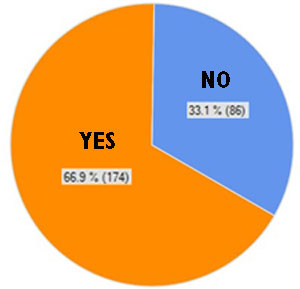 . other matters as required,” and to quantify how much of their work time is consumed by tasks across all categories of responsibility: tasks required of all, additional professional responsibilities (required of full-timers only), and voluntary activities. After having thoroughly reflected in this way on their patterns of usual, contractually defined work tasks, faculty answered this question: “Do you believe you routinely perform duties that are not specifically required of you by your contract?” A definitive 70 percent of faculty respondents answered yes, over half reporting that those extra-contractual tasks consume up to 20 percent of the average work day.
. other matters as required,” and to quantify how much of their work time is consumed by tasks across all categories of responsibility: tasks required of all, additional professional responsibilities (required of full-timers only), and voluntary activities. After having thoroughly reflected in this way on their patterns of usual, contractually defined work tasks, faculty answered this question: “Do you believe you routinely perform duties that are not specifically required of you by your contract?” A definitive 70 percent of faculty respondents answered yes, over half reporting that those extra-contractual tasks consume up to 20 percent of the average work day.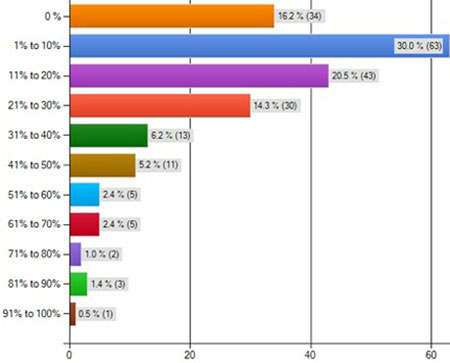



 While continuing his work as a kinesiology professor, Chip’s current research concerns brain plasticity using Wii balance games, mirror exercises, a rebounder and Interactive Metronome. In fact, Chip has had one or more research projects on-going for the past four years–now starting his fifth year. All projects are funded from the Skyline College President’s Innovation Grants and are collaborative research with Biologist, Shari Bookstaff, who provided Chip with the inspiration to do brain research due to her brain/body response to a brain tumor surgery. All of Chip’s subjects are students enrolled in Adaptive Kinesiology.
While continuing his work as a kinesiology professor, Chip’s current research concerns brain plasticity using Wii balance games, mirror exercises, a rebounder and Interactive Metronome. In fact, Chip has had one or more research projects on-going for the past four years–now starting his fifth year. All projects are funded from the Skyline College President’s Innovation Grants and are collaborative research with Biologist, Shari Bookstaff, who provided Chip with the inspiration to do brain research due to her brain/body response to a brain tumor surgery. All of Chip’s subjects are students enrolled in Adaptive Kinesiology. doors to college education open since the economy collapsed in 2008. We are now emerging from a long period of deprivation. I want to work closely with our faculty as we rebuild the promise of a higher education for all who seek it.
doors to college education open since the economy collapsed in 2008. We are now emerging from a long period of deprivation. I want to work closely with our faculty as we rebuild the promise of a higher education for all who seek it. changed, that great teaching and opportunity to learn inspires individuals to become all they can be. This was an especially fulfilling experience for me because it connected with all the values, ideals and aspirations I had at the beginning of my career that caused me to become a teacher. It was for me, a sort of realized “Ithaca”, a journey I wish to continue.
changed, that great teaching and opportunity to learn inspires individuals to become all they can be. This was an especially fulfilling experience for me because it connected with all the values, ideals and aspirations I had at the beginning of my career that caused me to become a teacher. It was for me, a sort of realized “Ithaca”, a journey I wish to continue. CSM’s Associated Students Advocacy Board will present a Town Hall for the four San Mateo County Coard of Trustees candidates on Tuesday, October 15 from 12:30 to 2:00 p.m. at CSM’s Bay View Dining Room in Building 10. The four candidates who will speak at the Town Hall are Samuel J. Diaz, Richard Holober, Tom Mohr and George Yang.
CSM’s Associated Students Advocacy Board will present a Town Hall for the four San Mateo County Coard of Trustees candidates on Tuesday, October 15 from 12:30 to 2:00 p.m. at CSM’s Bay View Dining Room in Building 10. The four candidates who will speak at the Town Hall are Samuel J. Diaz, Richard Holober, Tom Mohr and George Yang.
